Freshwater Stingrays
Stingrays, like sawfish and sharks, are cartilaginous fish. This means that although they are very different animals, they share the unique characteristic of having a body made entirely of cartilage, which makes them lighter, more flexible and agile.
Most rays live near the ocean floor where they feed on worms, insects, crustaceans, mollusks, and fish. Their flattened bodies and broad fins allow them to cover a larger area when foraging and facilitate camouflage.
Stingrays usually live in salt water, but the family Potamotrygonidae, found only in South America, is the only group of elasmobranchs that has adapted to live exclusively in fresh water.1.
The Potamotrygonidae family
The taxonomic history of the family Potamotrygonidae is full of mistakes and uncertainties. These animals have a large color variation, and individuals of the same species may have different spot patterns, so appearance is not always the most accurate way to distinguish them1. In the past, such a feature led to the description of synonymous species, and still causes doubt in identification2.
In addition to variations in color and pattern, there is also a wide range in size., measuring from 30 cm (11 in) (P. wallacei) to 1.6 m (5 ft) (P. aiereba), and weighing up to 110 kg (242 lbs), one of the heaviest freshwater fishes - ranking alongside the pirarucu and the piraíba.
To date, 31 species of freshwater rays are recognized, distributed in 4 genera: Heliotrygon (2 spp.), Paratrygon (3 sp.), Plesiotrygon (2 spp.), and Potamotrygon (26 spp.). Brazil is home to 24 species that live in the country’s major basins - with 22 found in the Amazon basin, 6 in the Paraná basin, and 3 in the Parnaíba basin. 3 4
Heliotrygon
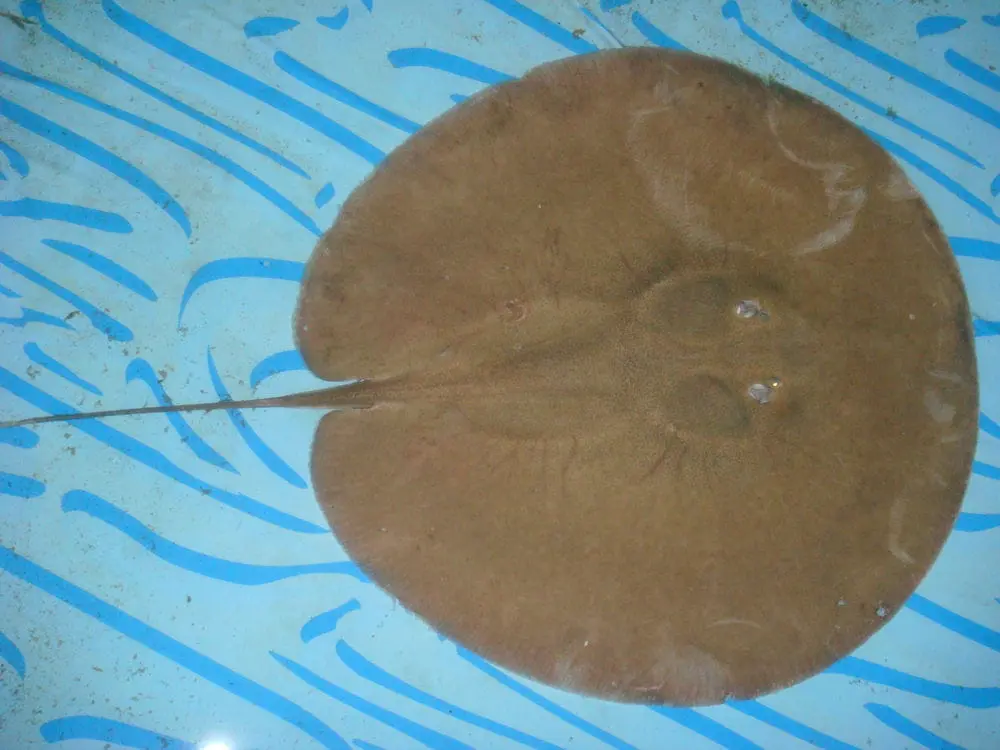
The two species of rays in this genus are H. gomesi and H. rosai, known as round rays because they are the most circular of all freshwater rays - which are more oval shaped. Although they were discovered decades ago, they were not officially described until 2011.
H. gomesi can reach up to 58 cm (23 inches), while the largest officially recorded size for H. rosai is 80 cm (31 inches); however, there have been reports of specimens as large as 1 m (3 ft). Despite their size, the spines of rays in this genus are vestigial and among the smallest of all rays, thus they have low toxicity and cause small wounds - therefore, they are considered harmless. 5
Both species are grayish or brownish on top, but while H. gomesi generally has no spots, H. rosai has a pattern of dark spots.
Paratrygon
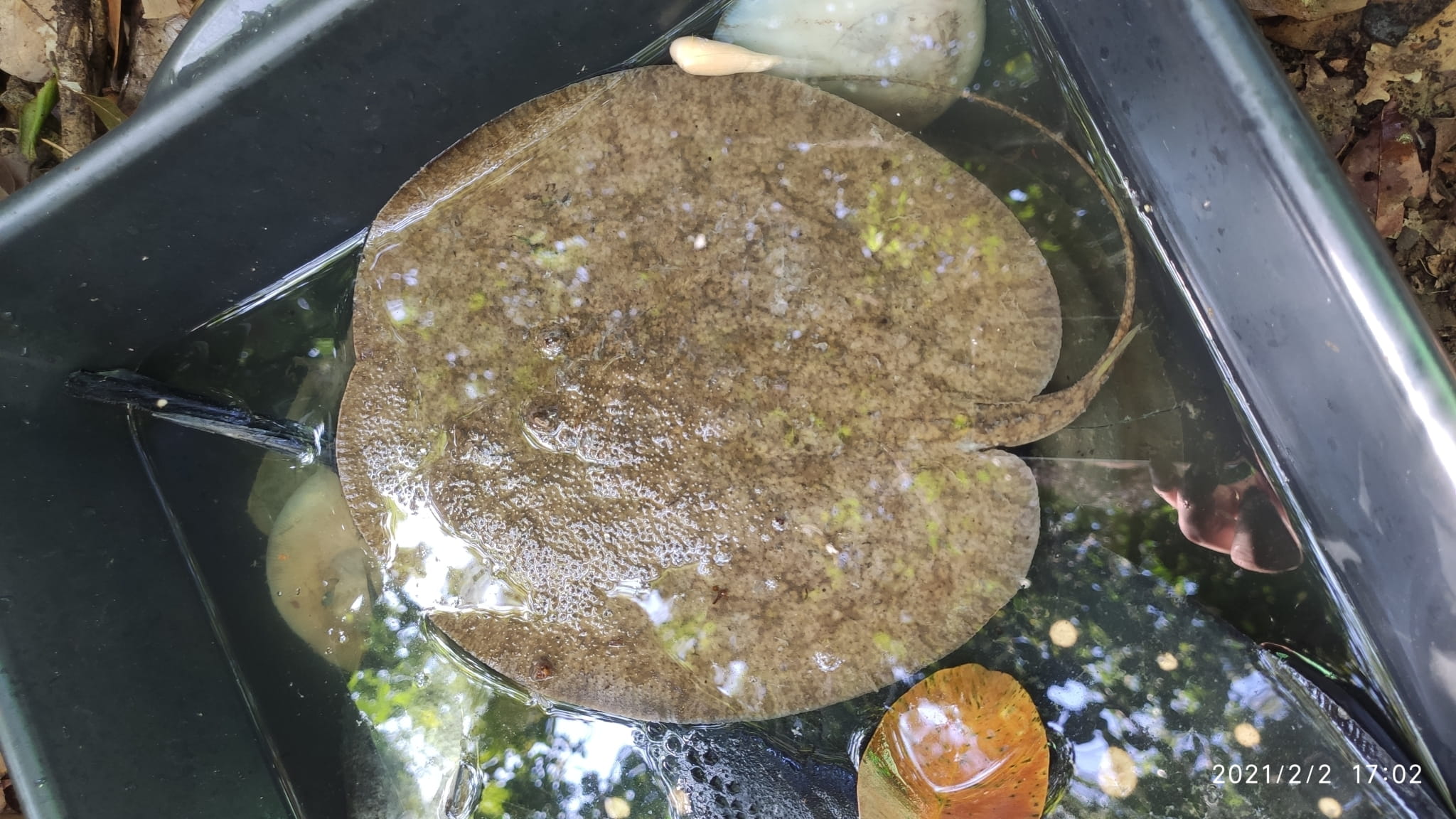
The genus Paratrygon has three species; two (P. parvaspina and P. orinocensis) were only discovered in 2021 and inhabit the Orinoco River in Venezuela4 The third and most studied species is P. aiereba, known as the discus ray or apple ray. It is found throughout the Amazon basin and its tributaries, both in Brazil and in other countries.
The discus ray is one of the largest rays in the world, reaching up to 1.6 meters (5 ft) in length and 110 kg (424 lb). However, most individuals reach up to 1.30 m (4 ft) and 60 kg (132 lb). It feeds primarily on fish, but may occasionally eat insects and crustaceans, especially as a juvenile. It is one of the animals at the top of the food chain in its habitat.
Plesiotrygon
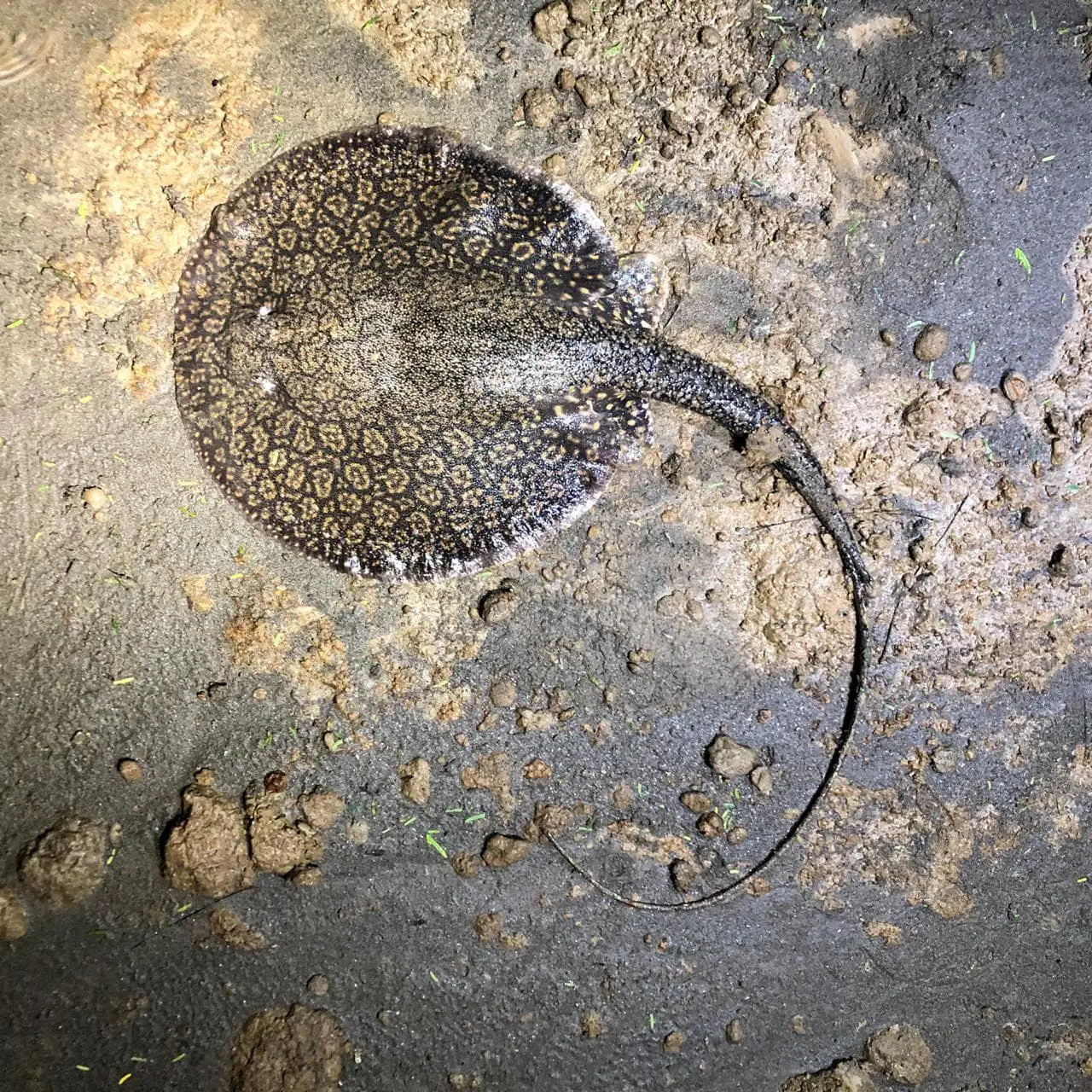
There are two species of this genus. One of them, P. iwamae, is known as the Long-tailed river stingray because of its long tail that is even twice the size of its body. The largest individual on record measured 65 cm (2 ft) in width. It feeds mainly on freshwater shrimp in the Amazon Basin - from Para to the Andes in Colombia, Ecuador and Peru.
The second species, discovered only in 2011, was named P. nana for its small size - reaching a maximum of 25 cm (9 in) in width. This one, is found only in the Amazon River in Brazil and Peru.3
Potamotrygon
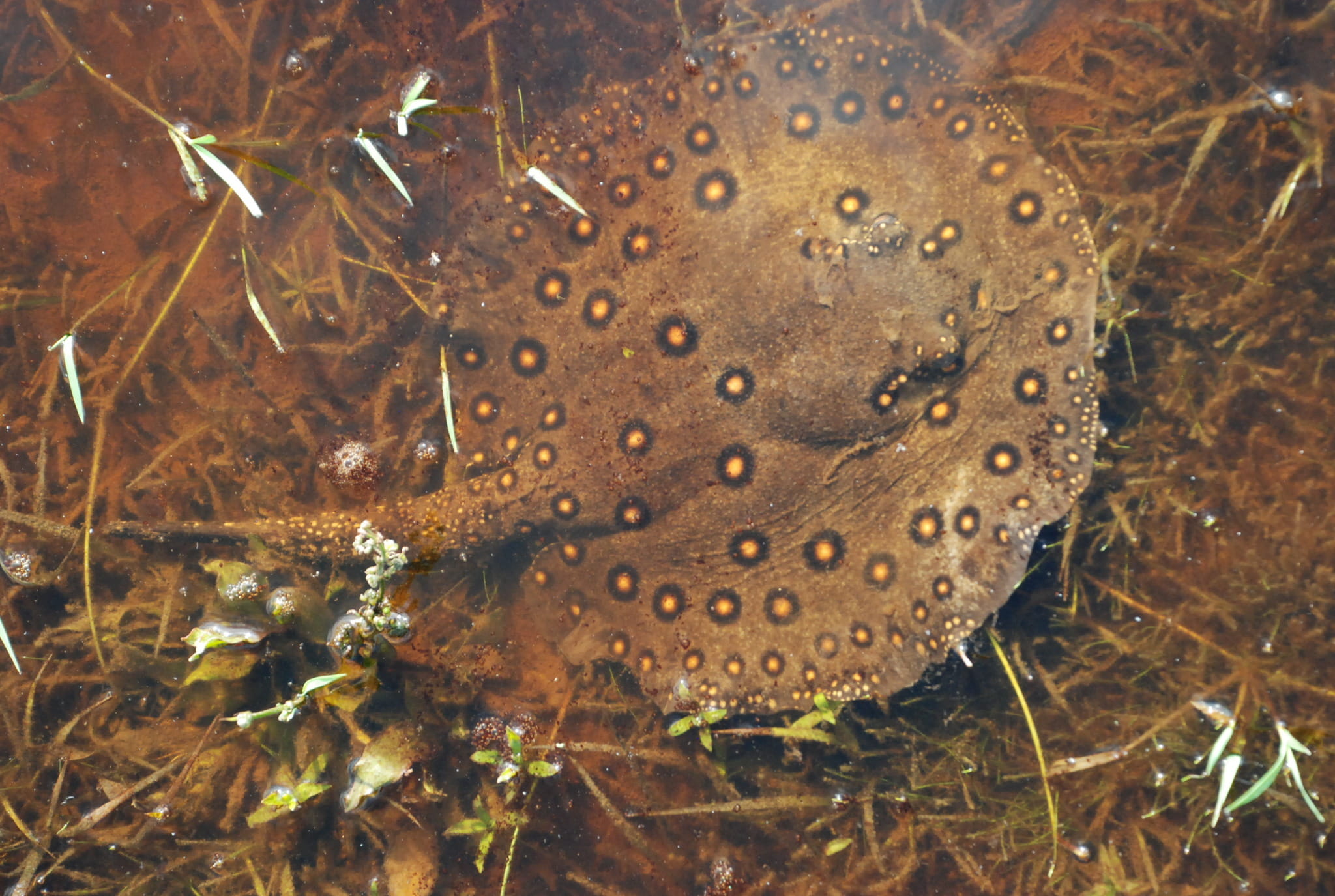
This is the genus with the largest number of species - some recently described. The ocellate river stingray (P. motoro), for example, was only described in 2009. The cururu stingray (P. wallacei), on the other hand, despite being known for decades had not been studied until 2016, when it was officially described as a new species.6
Stingrays of this genus vary considerably in pattern, color, and size, with disc width ranging from 30 cm (12 in) (P. wallacei) to 1.5 m (5 ft) (P. brachyura). In Brazil, most species inhabit the Amazon Basin, but some can also be found in the Paraná and Parnaíba River basins.3
Sting
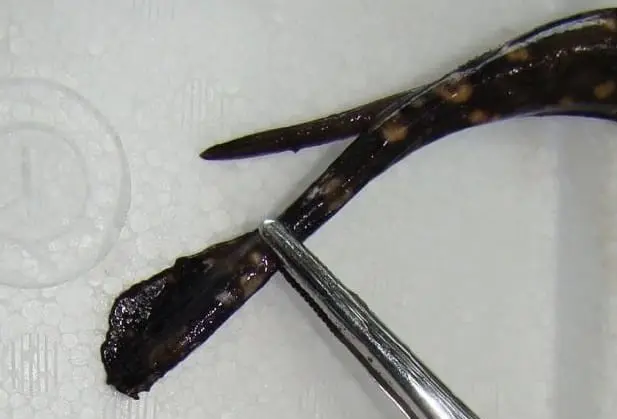
Stingrays are considered the most poisonous freshwater cartilaginous fish known to man. Some people who share their environment with these animals consider them more dangerous than piranhas or porpoises. Nevertheless, they are docile creatures and do not usually attack humans.
However, because they are benthic animals, they are usually hidden under the sand at the bottom of rivers. They can be accidentally stepped on by swimmers or unsuspecting fishermen. In this case, in a defensive behavior, they rotate their body, move their tail rapidly, and insert the sting into the victim’s foot.
Not all rays have stings, but all freshwater rays do. Each species has a different number, ranging from 1 to 37 and sizes from 2 cm to 37 cm (0.7 in to 14.5 in). The toxicity of the venom also varies within each species, depending on sex and age.8 A 2007 study showed that the stings of freshwater stingrays have more venom-secreting cells than marine stingrays, which may contribute to the greater severity of the wound.
Also, unlike a spear or needle, stingray stings are serrated and have denticles in the opposite position, so their removal causes even more damage than their insertion - increasing the severity of the wound. In addition to the stings, some species have denticles on the back and several mineralized tubercles along the tail that can also cause poisoning.
Stingray venom causes punctures, severe pain throughout the limb, tissue inflammation and necrosis. Patients may also experience nausea, vomiting, salivation, sweating, difficulty breathing, muscle contractions, and convulsions.
Stingray accidents tend to be most severe in the Amazon Basin regions when they occur in remote, isolated locations and often without medical attention. However, fatal injuries are rare, except in cases where the sting reaches vital organs. In Brazil, there have been no reports of fatal accidents involving freshwater stingrays.
Unfortunately, there is still no specific antidote for stingray venom and treatment is based on the use of analgesics, anti-inflammatories and antibiotics. If you are injured by a stingray, it is recommended that you wash the wound under running water to remove as much of the venom as possible,7 then immerse the injured limb in warm water to relieve symptoms while the patient is transported to the nearest medical facility. One should not attempt to suck the venom out of the wound or apply any substance not intended for treatment, such as any type of oil, butter, coffee, etc.
Threats and conservation
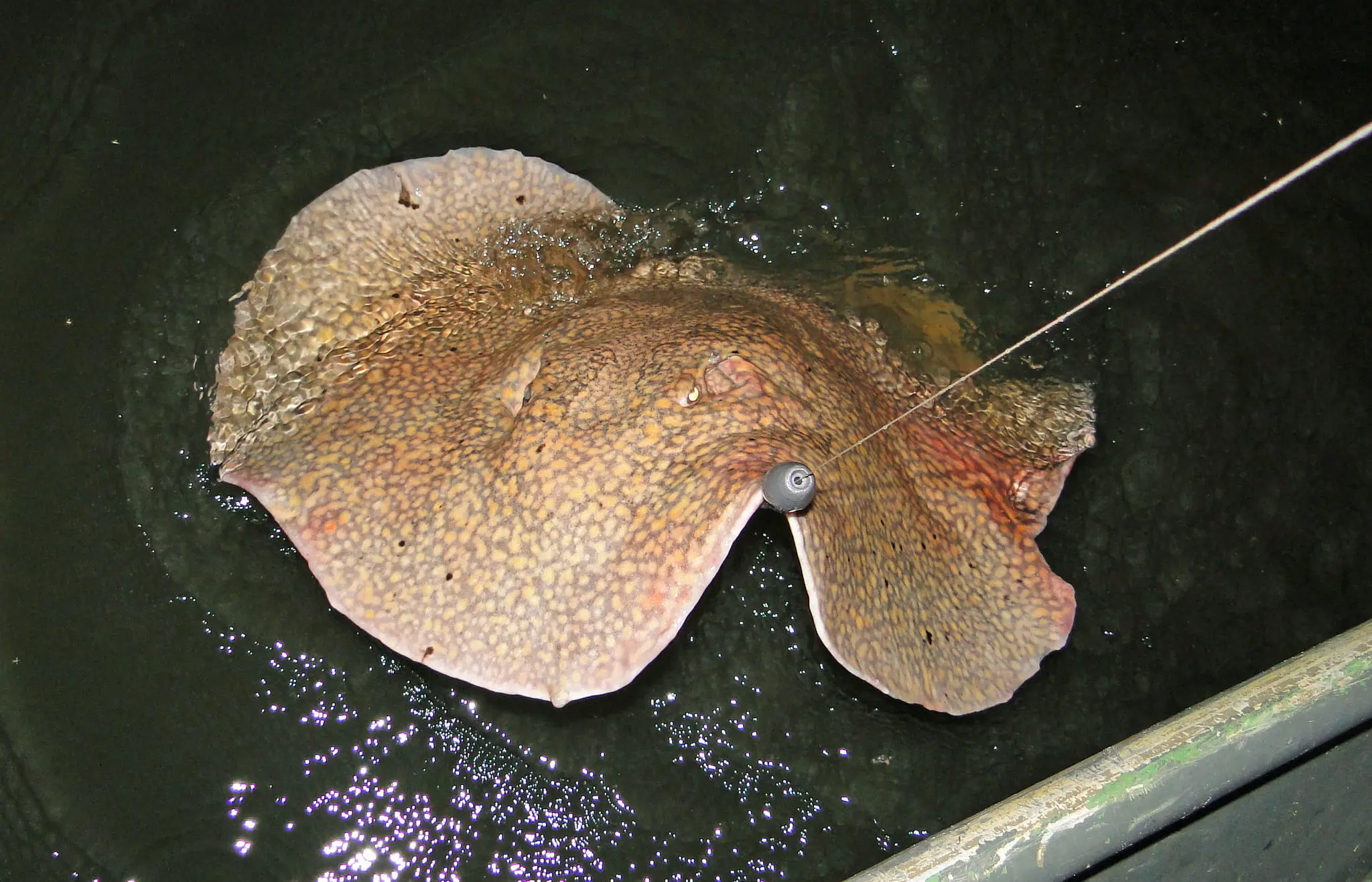
Like their marine counterparts, freshwater stingrays have slow growth, delayed sexual maturation, and low fecundity. Habitat degradation associated with the expansion of agriculture, cattle ranching, gold mining, and logging threatens these animals by releasing pollutants into the water. In addition, these rays are ultimately used as a food source by river dwellers and have been captured for aquarium breeding for decades.
In the late 1990s, a partnership between IBAMA and other scientific institutions created a quota system for species that could be exported (Regulations 022/98 and 036/2003). Although official export statistics have been available since 1998, they represent only a percentage of what is traded. While very few species and limited quantities are allowed to be exported, more than 20 species are exported illegally1 in alarming quantities.
Fishing is allowed in some places, such as the mouth of the Amazon River, but although it is monitored, there is no data on the amount allowed. It is estimated that if fishing is not controlled and pollution and trafficking are not stopped, there will be a population decline of more than 80% in three generations,9 possibly leading to the extinction of dozens of species.
Endemic species are naturally more vulnerable than those with wide distributions. Despite being an important part of the tropical ichthyofauna, these rays are poorly studied, and to protect them it is important to know the key environments in which they live so that they can be included in aquatic conservation programs.
An international program is needed to regulate the export of freshwater stingrays in the ornamental fish trade, and there are no effective regulations or controls on catches from commercial fisheries. Habitat maintenance and conservation are also key issues that should be included in management plans and need to be properly enforced through existing legislation.1
Read more:
-
Lúcia, Maria & Araújo, Góes & Charvet, Patricia & Almeida, Maurício & Pereira, Henrique. (2004). Freshwater Stingrays (Potamotrygonidae): Status, Conservation and Management Challenges. 8. ↩︎
-
LAMEIRAS, Juliana Luiza Varjão. Perfis protéicos, enzimáticos e miotoxicidade induzidos pelos venenos das arraias amazônicas Plesiotrygon iwamae Rosa, Castello & Thorson, 1987 e Potamotrygon motoro Müller & Henle, 1841 (Chondrichthyes Potamotrygonidae). 2013. 89 f. Dissertação (Mestrado em Imunologia Básica e Aplicada) - Universidade Federal do Amazonas, Manaus, 2013. ↩︎
-
Lasso, Carlos & Rosa, Ricardo & Morales-Betancourt, Monica & Garrone Neto, Domingos & Carvalho, Marcelo. (2016). Rayas de agua dulce (Potamotrygonidae) de Suramérica. Parte II: Colombia, Brasil, Perú, Bolivia, Paraguay, Uruguay y Argentina. ↩︎
-
Loboda, Thiago Silva et al. Two new species of freshwater stingrays of the genus Paratrygon (Chondrichthyes: Potamotrygonidae) from the Orinoco basin, with comments on the taxonomy of Paratrygon aiereba. Neotropical Ichthyology [online]. 2021, v. 19, n. 02 [Accessed 13 October 2022], e200083. Available from: https://doi.org/10.1590/1982-0224-2020-0083. Epub 11 June 2021. ISSN 1982-0224. https://doi.org/10.1590/1982-0224-2020-0083. ↩︎
-
The Guardian — New to Nature No 37: Heliotrygon stingrays ↩︎
-
Marcelo R. de Carvalho, Ricardo S. Rosa & Maria Lúcia G. de Araújo — A new species of Neotropical freshwater stingray (Chondrichthyes: Potamotrygonidae) from the Rio Negro, Amazonas, Brazil: the smallest species of Potamotrygon ↩︎
-
Lameiras, Juliana & Costa, Oscar & Dos-Santos, Maria & Duncan, Wallice. (2013). ARRAIAS DE ÁGUA DOCE (Chondrichthyes – Potamotrygonidae): BIOLOGIA, VENENO E ACIDENTES 1. Sci. Amazon.2. ↩︎
-
Juliane Monteiro dos Santos, Janaína Cardoso dos Santos, Elineide Eugênio Marques, Gessi Carvalho de Araújo, Carla Simone Seibert, Mônica Lopes-Ferreira, Carla Lima — Stingray (Potamotrygon rex) maturity is associated with inflammatory capacity of the venom ↩︎
-
Livro Vermelho da Fauna Brasileira Ameaçada de Extinção — Peixes ↩︎
